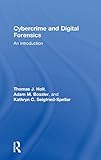Cybercrime and digital forensics : an introduction / Thomas J Holt, Adam M Bossler, and Kathryn C Seigfried-Spellar.
Material type: TextPublisher: London ; New York : Routledge, 2015Description: xiii, 486 pages ; 24 cmContent type:
TextPublisher: London ; New York : Routledge, 2015Description: xiii, 486 pages ; 24 cmContent type: - text
- unmediated
- volume
- 9781138021297 (hardback)
- 9781138021303 (paperback)
- 363.25/968 23
- HV6773 .H64 2015
- SOC004000
| Item type | Current library | Collection | Call number | Copy number | Status | Barcode | |
|---|---|---|---|---|---|---|---|
 Books
Books
|
Rabdan Academy General Stacks | General Collection | HV6773 .H64 2015 (Browse shelf(Opens below)) | 1 | Available | 158368 |
Includes bibliographical references and index.
"The emergence of the World Wide Web, smartphones, and Computer-Mediated Communications (CMCs) profoundly affect the way in which people interact online and offline. Individuals who engage in socially unacceptable or outright criminal acts increasingly utilize technology to connect with one another in ways that are not otherwise possible in the real world due to shame, social stigma, or risk of detection. As a consequence, there are now myriad opportunities for wrongdoing and abuse through technology.This book offers a comprehensive and integrative introduction to cybercrime. It is the first to connect the disparate literature on the various types of cybercrime, the investigation and detection of cybercrime and the role of digital information, and the wider role of technology as a facilitator for social relationships between deviants and criminals. It includes coverage of:key theoretical and methodological perspectives,computer hacking and digital piracy,economic crime and online fraud,pornography and online sex crime,cyber-bulling and cyber-stalking,cyber-terrorism and extremism,digital forensic investigation and its legal context,cybercrime policy.This book includes lively and engaging features, such as discussion questions, boxed examples of unique events and key figures in offending, quotes from interviews with active offenders and a full glossary of terms. It is supplemented by a companion website that includes further students exercises and instructor resources. This text is essential reading for courses on cybercrime, cyber-deviancy, digital forensics, cybercrime investigation and the sociology of technology"-- Provided by publisher.
"The emergence of the World Wide Web, smartphones, and Computer-Mediated Communications (CMCs) profoundly affect the way in which people interact online and offline. Individuals who engage in socially unacceptable or outright criminal acts increasingly utilize technology to connect with one another in ways that are not otherwise possible in the real world due to shame, social stigma, or risk of detection. As a consequence, there are now myriad opportunities for wrongdoing and abuse through technology. This book offers a comprehensive and integrative introduction to cybercrime. It is the first to connect the disparate literature on the various types of cybercrime, the investigation and detection of cybercrime and the role of digital information, and the wider role of technology as a facilitator for social relationships between deviants and criminals. It includes coverage of: key theoretical and methodological perspectives, computer hacking and digital piracy, economic crime and online fraud, pornography and online sex crime, cyber-bulling and cyber-stalking, cyber-terrorism and extremism, digital forensic investigation and its legal context, cybercrime policy. This book includes lively and engaging features, such as discussion questions, boxed examples of unique events and key figures in offending, quotes from interviews with active offenders and a full glossary of terms. It is supplemented by a companion website that includes further students exercises and instructor resources. This text is essential reading for courses on cybercrime, cyber-deviancy, digital forensics, cybercrime investigation and the sociology of technology"-- Provided by publisher.
There are no comments on this title.
